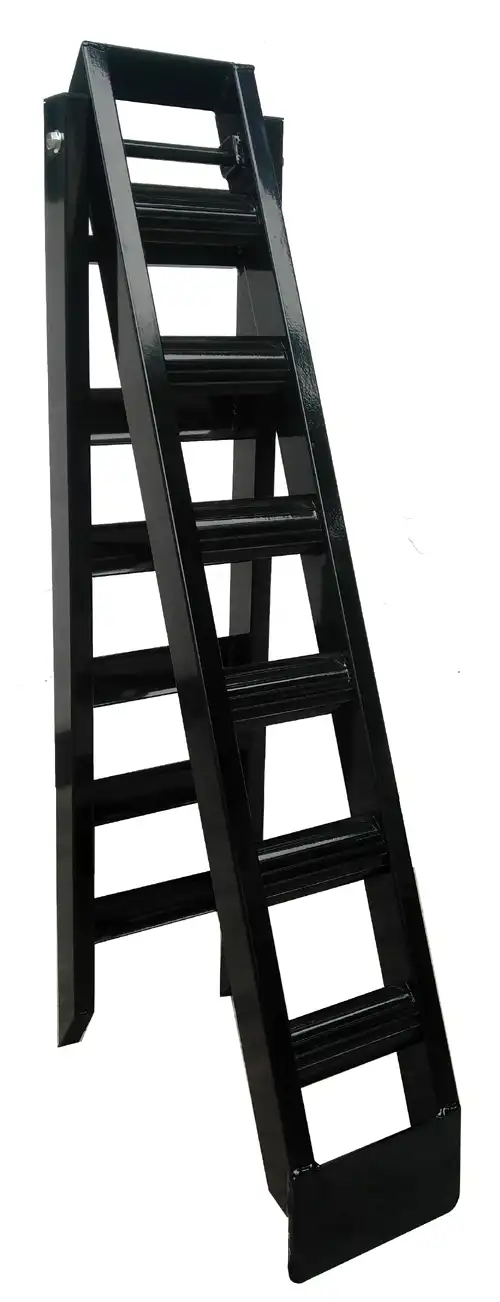Choosing the Right Motorcycle Ramp
Material Matters: Aluminum vs. Steel
When selecting a motorcycle ramp, the material plays a crucial role in its performance and durability. Lightweight steps made of aluminium are popular because they are easy to move and handle. Not only that, but they don't rust or rusting, so they will last even in bad weather. When it comes to power, steel ramps are better and can hold more weight. However, they are much heavy and might take more work to set up. Think on your needs, such how often you ride and how much your motorcycle weighs, while choosing between these materials.
Length and Width Considerations
The dimensions of your motorcycle ramp are vital for safe loading. You can ride your bike up a longer ramp with more confidence because the inclination is less steep. Generally, a ramp length of at least 7 feet is recommended for most motorcycles. The width is equally important – it should be wide enough to accommodate your bike's tires comfortably, with some extra space for minor adjustments. A width of 12 inches per track (for dual-runner ramps) or at least 30 inches for single-piece ramps is typically sufficient.
Weight Capacity and Safety Features
Always check the weight capacity of the ramp before purchase. It should exceed the combined weight of your motorcycle and any additional gear. Look for ramps with safety features such as serrated rungs or a high-traction surface to prevent slipping. Some ramps have safety straps or support pieces that can be adjusted to make them more stable while they're being loaded. These additions can greatly enhance your sense of security and self-assurance while utilising the ramp.
Proper Ramp Setup and Positioning
Securing the Ramp to Your Vehicle
Properly attaching your motorcycle ramp to your vehicle is paramount for safety. Most ramps come with a lip or fingers that hook onto the edge of your truck bed or trailer. Ensure this connection is snug and secure. For added stability, use safety straps or tie-downs to fasten the ramp to your vehicle. These should be tightened enough to prevent any movement but not so much that they bend the ramp. Always double-check these connections before attempting to load your motorcycle.
Optimal Angle for Easy Loading
The angle at which you set your ramp can make a significant difference in the ease and safety of loading your motorcycle. A general rule of thumb is to aim for an angle of about 15 to 20 degrees. This provides a balance between a gentle incline and a manageable ramp length. If the angle is too steep, you risk losing traction or control of your bike. Conversely, if it's too shallow, you may need an impractically long ramp. Adjust the positioning of your vehicle or choose a location with the right height differential to achieve this optimal angle.
Surface Preparation and Ramp Stability
Before setting up your ramp, inspect the loading area. The surface should be flat, level, and free from debris or obstacles. If you're loading on uneven terrain, use plywood or sturdy boards to create a level base for your ramp. Ensure the ramp is placed on a non-slip surface – rubber mats can provide extra grip if needed. Once positioned, check the stability of the ramp by applying some pressure with your foot. Any wobbling or movement should be addressed before attempting to load your motorcycle.
Loading Techniques and Safety Precautions
Proper Body Positioning and Balance
Your body position is crucial when riding your motorcycle up a motorcycle ramp. Stand up on the footpegs to lower your center of gravity and improve balance. Keep your arms relaxed but firm on the handlebars, and look ahead towards the top of the ramp, not down at your front wheel. This helps maintain a straight line and prevents veering off course. Lean slightly forward to counteract the incline, but avoid excessive forward lean which can cause the front wheel to lift.
Throttle and Clutch Control
Smooth, controlled throttle application is key to safely ascending the ramp. Start with a steady idle and gradually increase throttle as you approach the ramp. Use the clutch to modulate power delivery – this gives you finer control over your speed. Avoid sudden throttle inputs which can cause wheel spin or unexpected acceleration. If your bike has different power modes, consider using a less aggressive setting for more predictable power delivery. Remember, it's better to go too slow than too fast when loading your motorcycle.
Emergency Procedures and Spotter Assistance
Despite careful preparation, things can sometimes go awry. Have an emergency plan in place. If you feel the bike tilting or losing traction, gently apply the brakes and try to keep the handlebars straight. In worst-case scenarios, it's better to let the bike fall than to risk injury trying to save it. This is where having a spotter becomes invaluable. A spotter can guide you, warn of any issues, and provide immediate assistance if needed. They should stand to the side of the ramp, clear of the bike's path, ready to offer verbal guidance or physical support if necessary.
Conclusion
You must learn how to use a motorcycle ramp properly if you ever need to move your bike. You may greatly lessen the likelihood of harm coming to your motorbike if you select an appropriate ramp, put it up appropriately, and use suitable loading practices. The most important thing is to practise and be patient. Be cautious at all times, move slowly and deliberately, and take your time. Remembering these steps will make loading and unloading your motorbike a breeze, leading to many more fun miles on the road.
Contact Us
For more information about high-quality motorcycle ramps and other motorcycle maintenance tools, please contact us at info@runva.com.cn. Our team of experts is ready to help you find the perfect solution for your motorcycle transportation needs.

_1737625693698.webp)


